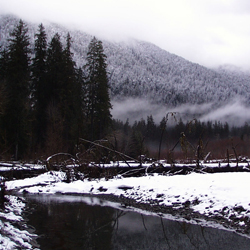
This is a work in progress...
If you're going to do a story of a trip down a river, you need some birds. There are lots of birds along the Hoh River. The U.S. National Forest Service has a wonderful map and pictures at that link, with the names of some of the birds in upland, forest, and wetland habitat of the river. Thanks to the Peterson Guides for the bird calls in this collection.
HABITAT: Olympic National Park old-growth rainforest of moss-draped maples, black cottonwood, conifers; wetlands, Hoh River.That's where it gets interesting. This was mixed with Csound.
BIRDING: Riparian deciduous trees rustle with Hammond’s Flycatchers, Warbling Vireos, Black-throated Gray Warblers, Downy Woodpeckers. Stately conifers sustain Hairy and Pileated Woodpeckers, Pacific-slope Flycatchers, Chestnut-backed Chickadees. Ponds host Green-winged Teals, Ruddy and Ring-necked Ducks, Hooded Mergansers.
VIEWING: Walk 0.7-mile Hall of Mosses loop, 1.2-mile Spruce Nature Trail.
ACCESS: From Hwy 101 at milepost 178.5, turn east onto Upper Hoh Rd. Drive 19 miles. Park at Olympic National Park Visitor Center.
MORE BIRDING: For seriously hardy birders, 18.5-mile Hoh River Trail ascends to alpine meadows for Gray-crowned Rosy Finches, Black Swifts.



